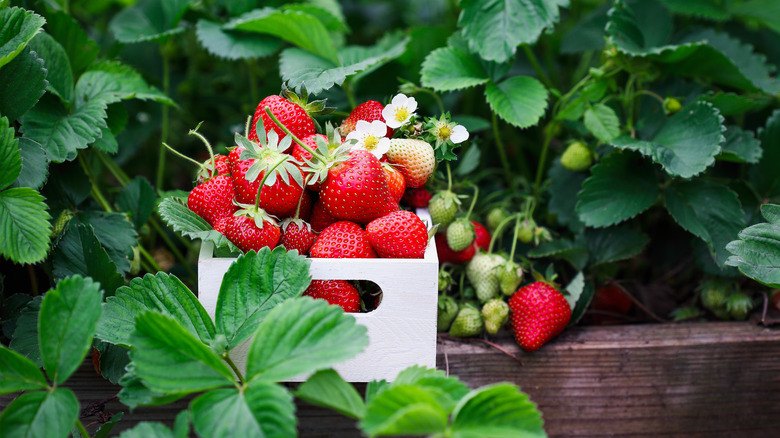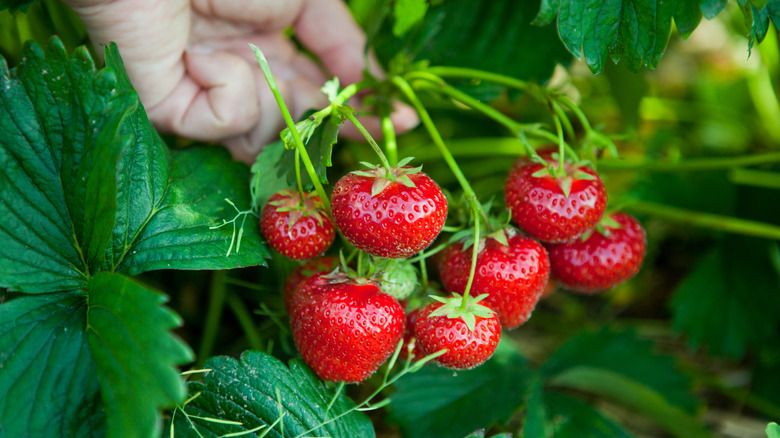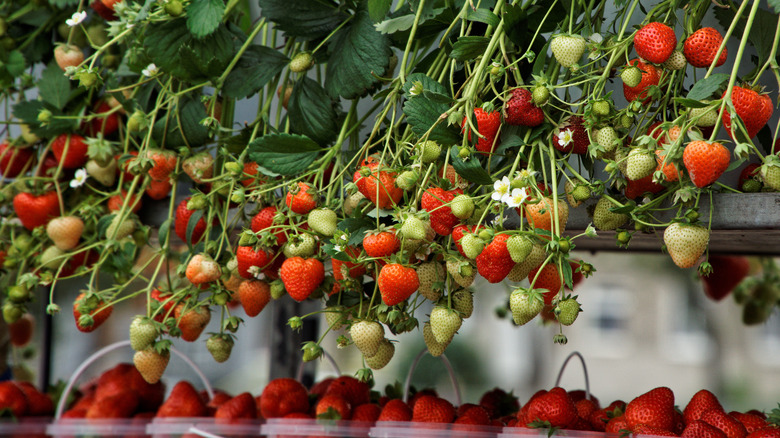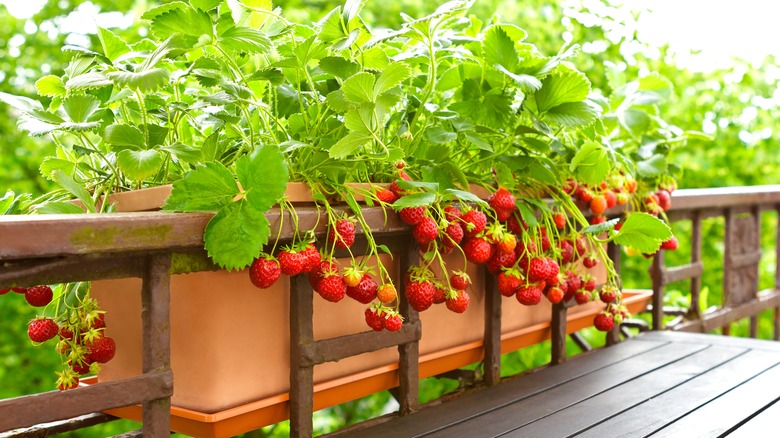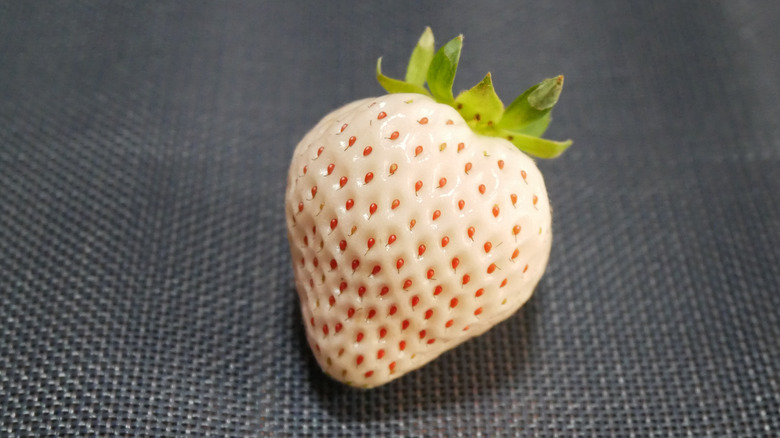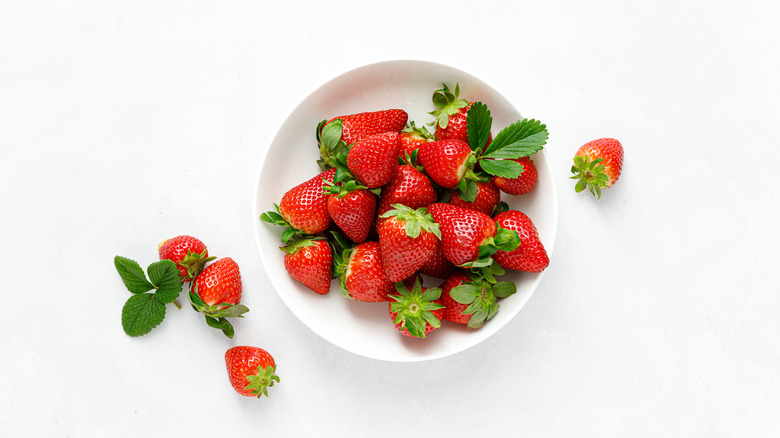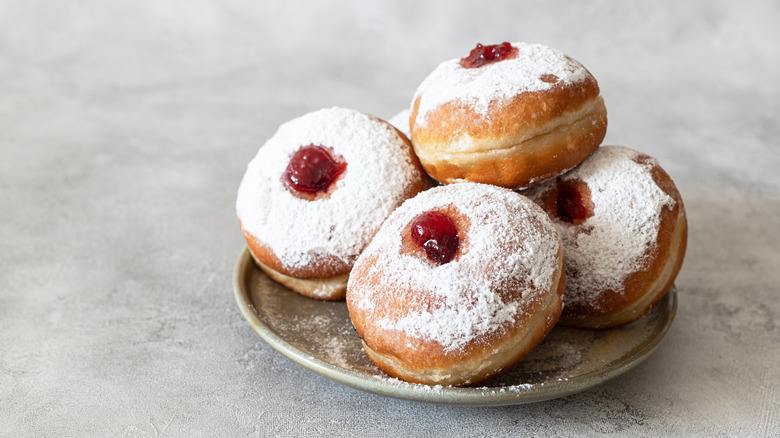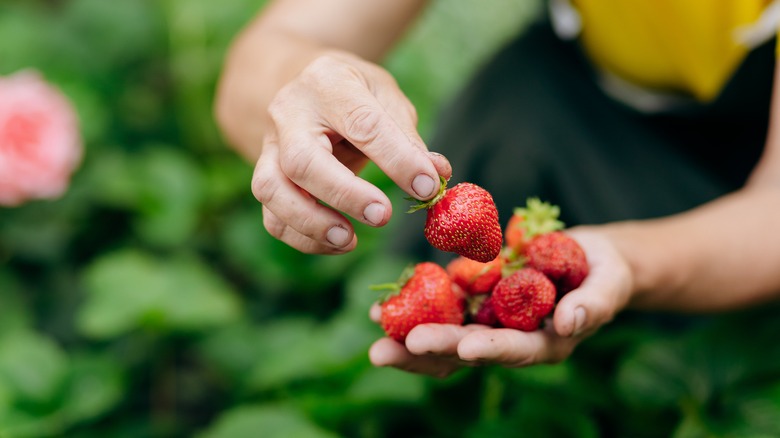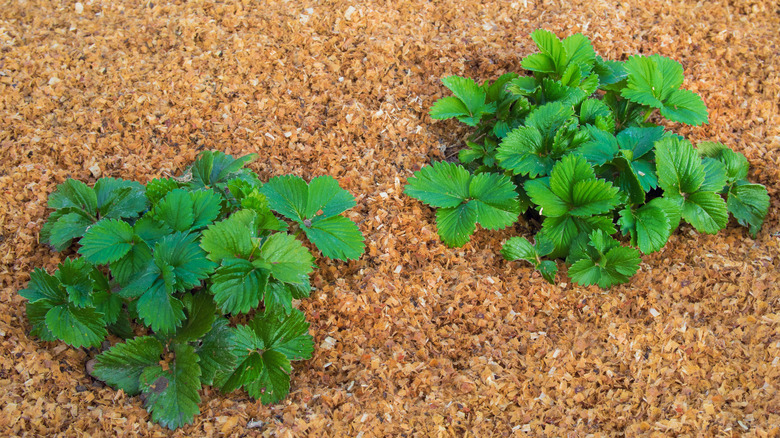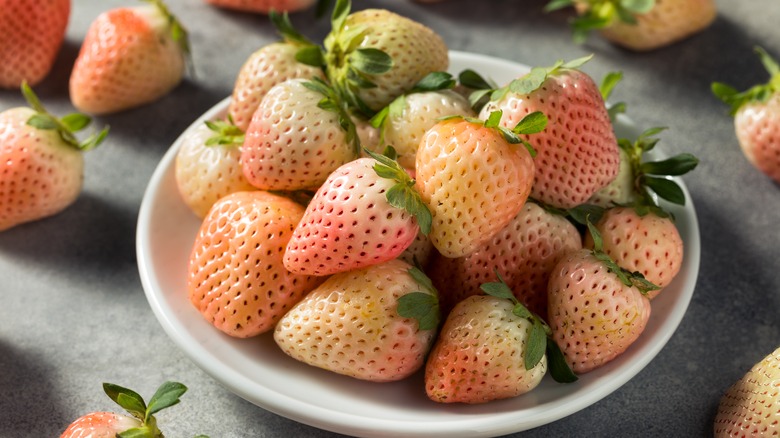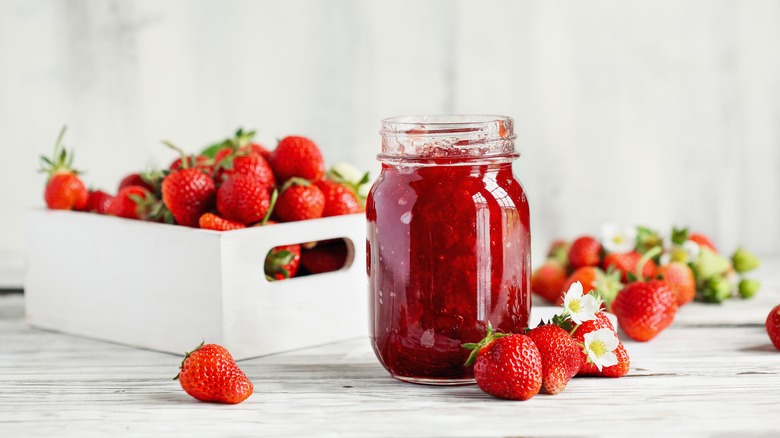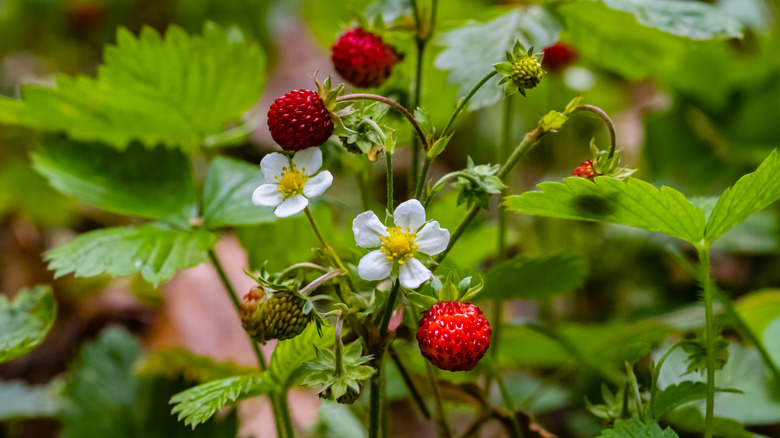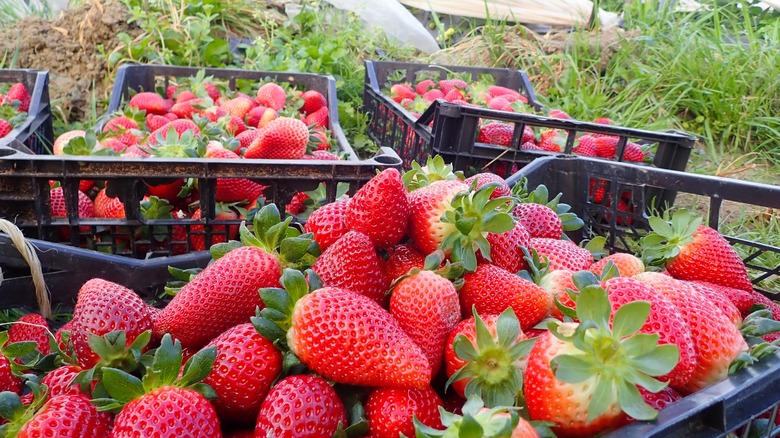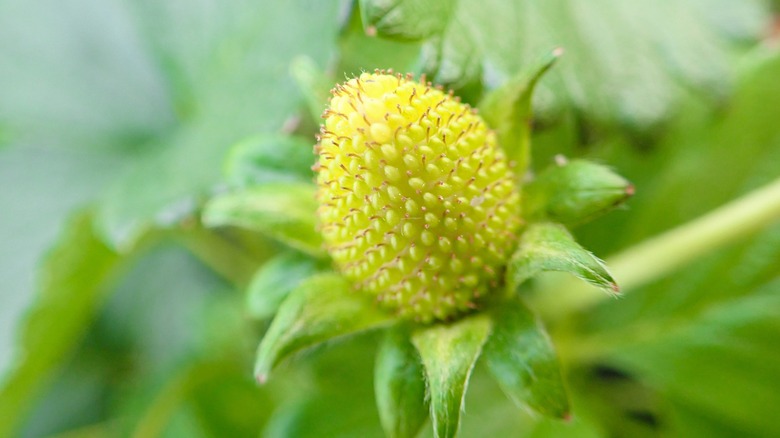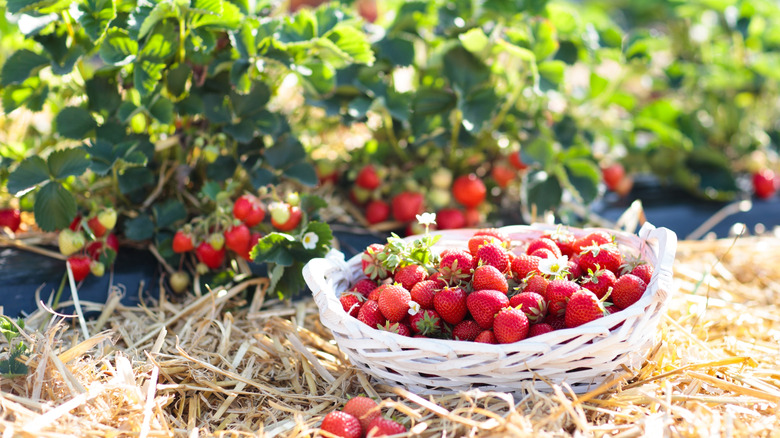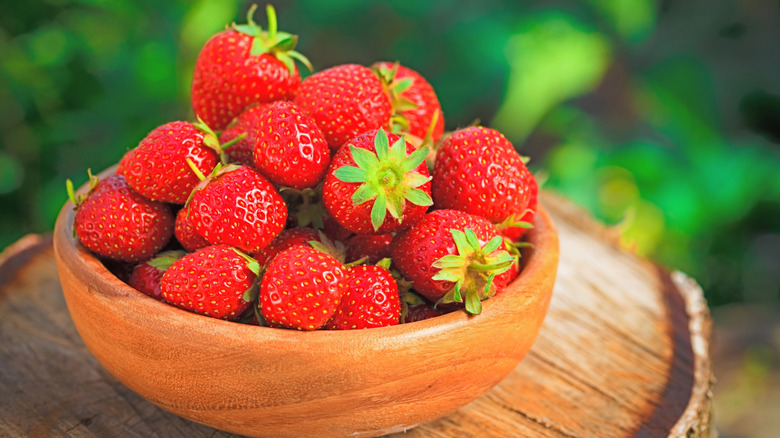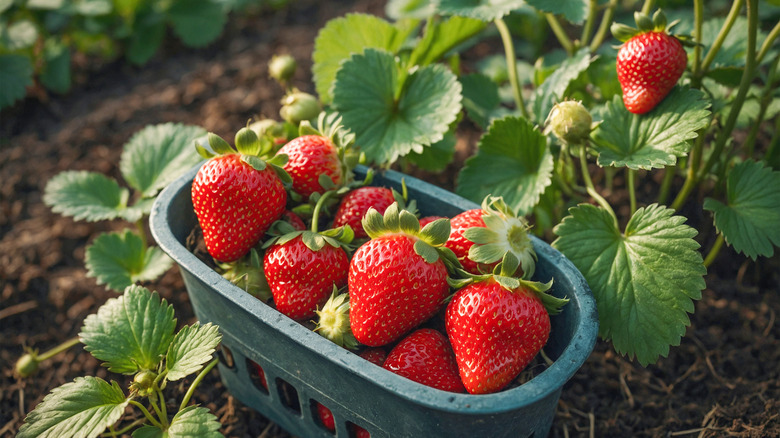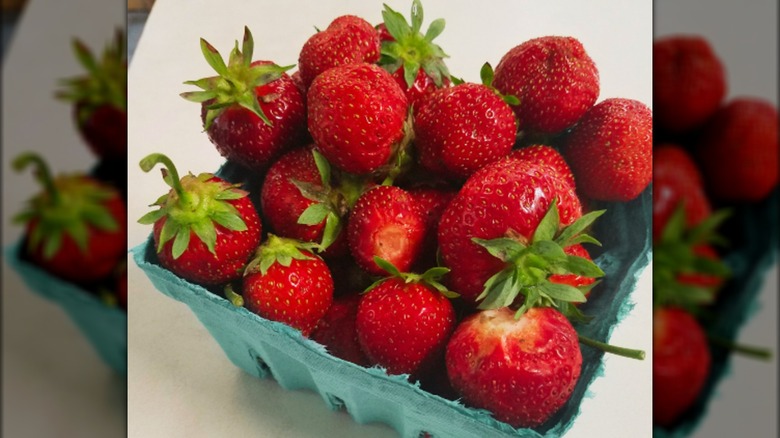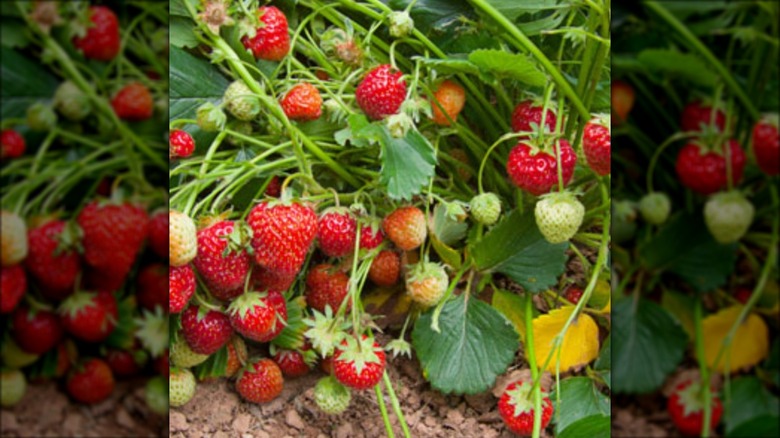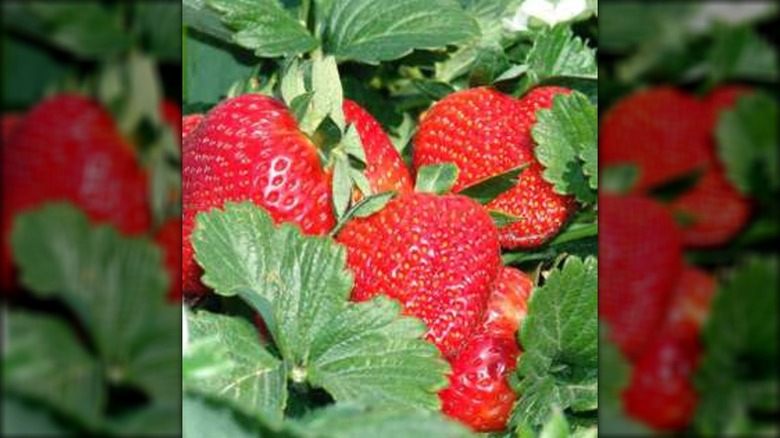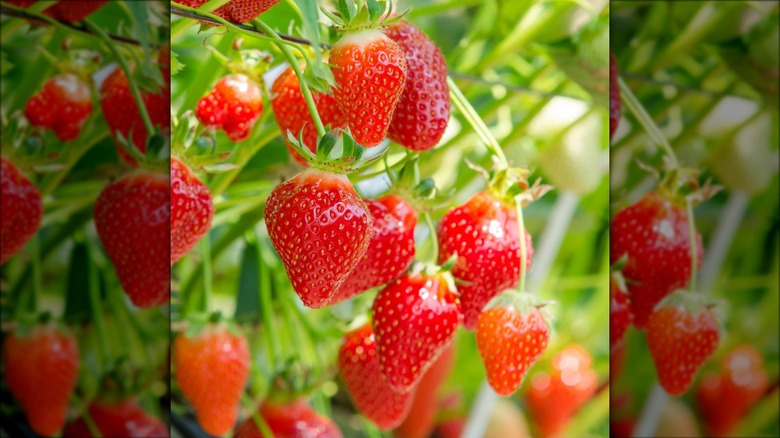22 Varieties Of Strawberries, Explained
Come spring and summer, nothing beats fresh strawberries. Whether you like to eat them fresh, in smoothies, in different desserts, with breakfast, or in some other way, a juicy, delicious strawberry — ideally picked recently — is definitely a treat. And there are so many types of strawberries to choose from.
While strawberries are pretty easy to find year-round, the best are always the freshest. Unless you're lucky enough to live in a climate that can produce them more or less throughout the year (like parts of California), late spring and early summer are the times to get them.
Of course, as you'll read below, that doesn't mean June is the only time to have fresh strawberries. There's actually considerable variety in when and how strawberries ripen, and within that diversity, additional variety between types of plants, which are bred for characteristics like size, color, disease resistance, and more.
So to learn a little more about this essential fruit, read on!
June-bearing strawberries
Generally speaking, there are three varieties of strawberries: June-bearing, everbearing, and day-neutral. As the name suggests, the first of these types produces one crop annually, which is generally in June. June-bearing strawberries are quite common, especially for home gardeners (though other types are available, if you're thinking of planting your own strawberry patch, as you'll see below).
June-bearing strawberries are popular, in part, because they're reliable. Barring a killing frost, they will consistently produce a batch of juicy, red strawberries every year. And as the University of Wyoming points out, there are ways to ameliorate the risk of a frost, like growing them in high tunnels or mulching them.
Because June-bearing plants put all their energy into a single annual production, healthy plants tend to produce big, rich strawberries. Of course, because all the strawberries come at once, the harvest can sometimes get a little overwhelming. But such a bounty also affords the opportunity to get creative with the fruit. You can try pickling them, making strawberry jam, or just finding delicious recipes to try, like this strawberry spoon cake.
Everbearing strawberries
This second category of strawberries actually has a slightly misleading name. Everbearing strawberries don't produce strawberries continuously; rather, they typically produce two crops each year, one roughly in July and the second in August–September. This type of plant might sound ideal. After all, why settle for only one crop of fruit in June when you can get two crops later in the year? Plus, the delayed fruiting time does mitigate the risk of a killing frost.
While the double harvest, and the delayed harvest, are indeed often benefits with everbearing varieties, this type of strawberry does come with some drawbacks worth considering. In general, an everbearing strawberry plant will not produce strawberries as big and rich as you'll get with a June-bearing variety. That doesn't mean they aren't tasty — varieties like Fort Laramie and Ogallala are indeed quality producers. But you might not get the same, picture-perfect strawberries you'll get with a June harvest.
Day-neutral strawberries
Finally, there is the third major category of this type of fruit: day-neutral strawberries. The slightly obscure name refers to a variety of plant that produces fruit more or less continuously throughout the growing season. As with everbearing strawberries, this might immediately strike budding gardeners and fruit lovers as ideal. After all, isn't an ongoing crop, potentially for several months, superior to a single crop of berries in June?
For some strawberry growers, this may indeed be a good choice. But as with everbearing varieties, day-neutral varieties do have some drawbacks. One is that these plants are generally grown as annuals — rather than perennials — meaning they must be replanted every year. One of the joys of growing strawberries is having a particular patch come back year after year; with day-neutral varieties, that won't usually be the case.
That said, annually planting them can sometimes be a benefit. It allows more flexibility for gardeners with limited space, as such varieties can often conveniently be grown in containers. And pound for pound, these do tend to yield more strawberries per plant than June-bearing varieties.
White strawberries
For most people, the color red instantly comes to mind when you think of a strawberry. Red strawberries are what most farmers grow, what we tend to find in grocery stores, and what strawberries usually look like in breakfasts and desserts.
However, not all strawberries are red, and white strawberries have gotten increasingly popular in recent years. White strawberries are strawberries with low levels of a protein (Fragaria allergen 1) that gives typical red strawberries their color. Unlike most strawberries, which turn redder as they fully ripen (and should only be picked when fully red), white strawberry varieties retain their lack of color even when fully ripe.
But that doesn't mean they're not tasty. Alpine strawberries, beach strawberries, and pineberries are all interesting varieties from all over the world that you can try, if you can find them (or, alternatively, if you choose to grow them yourself). White strawberries tend to be sweeter and softer than red varieties. They can also be considerably more expensive in stores (a rare Chilean variety goes for $13 a pound). But if you're a strawberry lover, trying them is essential.
Albion
Categorizing strawberries can be a little confusing. The categories listed above refer to general varieties of strawberries, but within each type there's quite a bit of variation, ultimately adding up to hundreds of unique varieties of strawberries in total.
One popular variety is called Albion. Albion is a relatively new development, first bred in California. They are a day-neutral variety, which means they produce consistently throughout the season. This variety is particularly notable for the large, juicy, red fruits it produces. They also show some disease resistance, which is helpful for novice home gardeners — and anyone who doesn't want their produce succumbing to Verticillium wilt, Phytophthora crown rot, or another disease that affects strawberries.
Albion, in short, is a reasonable choice if you're interested in growing strawberries for the first time. But remember, being a day-neutral variety, this type of strawberry won't lend itself to a long-lasting strawberry patch. Instead, you'll have to replant every year.
Allstar
Maybe you want to keep it simple with strawberries. You want all your strawberries to come at once; you're prepared for a big harvest, ready to eat some fresh and process others into jams, chia oatmeal bars, or something else tasty.
In that case, there are worse places to start than with the Allstar variety. Allstars are June-bearing, so you get one crop a year — but under good conditions, it should be a substantial crop, and for a couple of weeks, you may have more strawberries than you know what to do with.
This is a reasonably easy-to-grow and fairly hardy variety, and can be grown at least to USDA zone 5 (and maybe farther north, with adequate protection). If you do try planting it on your own, be sure to remove any blossoms and runners after its first year — with some luck, this will help produce more strawberries the next year.
And of course, get experimental as you work to eat all your strawberries. This strawberry cobbler is a good place to start.
Sparkle
Another June-bearing variety that definitely warrants some attention is called Sparkle. As the colorful name suggests, Sparkle is a flashy, high-quality variety of June-bearing strawberry. It's a vigorous choice for a farm or home garden, and does have some helpful disease resistance, which can definitely offer a little peace of mind.
But if you're into berry processing, Sparkle is an especially good choice. Whether your preference is strawberry jam, or you're into making something more complicated — like a strawberry jelly donut — Sparkle is an excellent choice.
It's also particularly good for freezing, which is extremely handy. Freezing strawberries is, in general, a great tactic with June-bearing varieties, helping them last longer and allowing them to be used in dishes throughout the year (and freezing fruit is easy to do). In many recipes, frozen berries can simply be used as a substitute for fresh berries, and are particularly useful in certain dishes (like in smoothies).
Fort Laramie
Fort Laramie, mentioned above, is a quality everbearing strawberry — which means it should, under the right conditions, produce two crops annually. Under the best conditions, Fort Laramie can potentially even produce three crops of strawberries per year!
If you're a home gardener looking for somewhere to get started producing your own fresh berries, Fort Laramie is not a bad place to begin. It's somewhat disease resistant, and, most importantly, the berries are great: a good size, deep red, great-smelling, and perfectly applicable to either eating right once they're picked, or processing for later use. With some luck, you may even be able to successfully grow it in a container. Just be sure that the plant is getting enough sun, and that the soil is sufficiently well-draining. And as with other strawberries, keep an eye out for common problems, like foliage diseases, root rot, and aphids and other problematic insects.
Seascape
Seascape is another popular variety of strawberry, and interestingly, it can be found listed as both an everbearing and a day-neutral variety. This variety is particularly exceptional for its high-quality fruits. It's also a relatively new variety: It was first bred and released for sale by the University of California in 1992.
Otherwise, it's pretty typical in terms of growing strawberries. It seeks sufficient sunlight daily (about eight hours, at least), soil that drains well, and enough water — be careful not to let it dry out. (At the same time, soggy soil is a problem; you want soil that drains well, or you might end up dealing with root rot.) If you're in a particularly cold climate, and you're trying to grow this variety, you should take appropriate precautions: A heavy straw mulch can keep plants warm in cooler weather, and help protect against killing frosts.
Pineberry
Thus far, we've covered the different general categories of strawberries (June-bearing, everbearing, and day-neutral), and a number of unique strawberry varieties, including white strawberries. But it turns out, apart from white strawberries, not all strawberries are necessarily red. Consider the pineberry. This is a particularly fascinating fruit and is a hybrid (like the common garden strawberry) between South American and North American strawberries. But most notably, this fruit is pink! It has a soft, light color with somewhat darker red seeds, putting it squarely between white and red strawberries.
But its unusual color isn't its only claim to fame. Pineberries get their name because they actually have a sweet taste reminiscent of pineapple. Of course, this does not mean they don't taste like strawberries; they certainly do, and contain other fruity notes — including pear and apricot — but the flavor is certainly original. They can be substituted in recipes that call for strawberries, but chefs should give some thought to places they might especially shine — as in, for instance, this rosé sangria with strawberries and dried flowers.
Honeoye
Sometimes, all you really need is a simple, high-performing, high-quality June-bearing strawberry. One crop a year may indeed be plenty for you — and it's fair to say that only having one crop of strawberries annually can make the harvest extra special.
If that's what you're after, a good variety might be Honeoye, an award-winning June-bearing variety. And it truly is award-winning: it has won the Award of Garden Merit from the Royal Horticultural Society. That's no surprise, because it produces large and delicious red berries that are fantastic fresh, but can also be processed and preserved, especially into strawberry jam, if that's what you're looking for.
When it comes to growing and planting, it's pretty standard as far as strawberries go. It shows some disease resistance but has to deal with many of the same problems as other strawberries — aphids, fruit rot, root rot, grey mold, and so on. Fortunately, these problems can be ameliorated with well-draining soil.
Tristar
Even though June-bearing varieties are probably the most common type of strawberry, and are popular for many experienced and beginner gardeners, it's true that there are benefits to other kinds of strawberries — like day-neutral varieties. The biggest, obviously, is probably continuous production. Because day-neutral varieties are not triggered to flower by the length of the day (as with June-bearing strawberries), they end up producing berries for potentially up to several months.
Day-neutrals are also unique in some other ways: Regular nitrogen and potassium are helpful for growth, and they require high amounts of boron. They do have unique disease problems: Grey mold can increase over the course of the season, particularly during wet periods, and so moldy berries should be removed quickly to avoid spread.
But if you want to give them a shot, another great variety to try is Tristar. It produces smaller berries, but they're very tasty. It's also a fairly hardy variety, showing resistance to red stele.
AC Wendy
There truly is no shortage of strawberry varieties; as noted above, there are hundreds of varieties of strawberry cultivars that can be found at home, at farmers' markets, and in grocery stores. It's an impressive range, and can also be intimidating. Where to start if you're looking for a good strawberry variety?
Truthfully, there are so many good options, odds are, you'll make a fine choice. And in that spirit, another good strawberry to consider is called AC Wendy. This is a tasty, June-bearing variety. Originally bred in Nova Scotia, this variety has a hardiness that's appropriate to its northern origins. It's also fairly amenable in terms of soil type, another good reason why it's a solid choice for new gardeners.
And — probably most importantly — it's good at producing a high yield of fruit. In fact, according to garden supplier Jung Seed, it can produce twice as much fruit as other June-bearing varieties. Not so bad — after all, that's probably what you're planting strawberries for!
Alpine yellow wonder
We've looked at red strawberries, white strawberries, and even pink strawberries. But there's at least one more color to consider: yellow. Yes, there are indeed varieties that produce yellow strawberries — and a popular one is called Alpine Yellow Wonder. This is a tasty everbearing variety that, like the pineberry, has a flavor profile reminiscent of pineapple (and the color to match). Its berries are on the smaller side, but it's a high producer, so that shouldn't dissuade you from this variety.
Finally, as an added bonus, the color makes this type of strawberry less attractive to birds. So unlike the red varieties, you won't have to spend as much time competing with wildlife to get a good harvest.
Otherwise, it's a pretty typical strawberry. It is hardy down to zone 3 — meaning it can tolerate some cold, though mulch will definitely help — and can even be grown well in containers. Just be sure it has access to sufficient sunlight.
Camarosa
While many strawberries are super hardy and can be grown even in the more intense, northern climates, that's not true for all varieties. Some definitely benefit from — or can only tolerate — a hotter year-round climate. If you live in that kind of environment — Southern California, for instance — it might be worth choosing a variety especially adapted to the heat.
One solid choice, with this in mind, is Camarosa. Given its tolerance, it's no surprise that it was developed in California's Central Valley, first created by the University of California, Davis in 1994. It is a hearty, June-bearing strawberry variety, and is a great producer, producing rich, large berries early in the season. But it's not necessarily for anywhere — it is particularly adaptable in hot and dry regions. While it's technically listed as hardy to zone 4, if you live in northern New England, it might be best to try something else. But on the West Coast or in the Southwest, this could be a good choice.
It does require regular watering and full sun, and mulch and compost will only help. But with the right climate and quality care, it'll produce a delicious crop of rich, red berries.
Aromas
Aromas are a type of day-neutral strawberry, which means that you'll need to replant them each year if you want to ensure a successful and healthy crop. Overall, the plants are considered very resilient, holding up well when grown in hardiness zones 3 to 9. If you've had issues with pests and diseases with other varieties, you may find better success with Aromas — they're resistant to various diseases and even spider mites.
Aromas strawberry plants typically produce fruit between June and October, providing you with delicious treats for several months of the year. The strawberries that the plants yield have a gorgeous, bright red color and are relatively large in size. You can enjoy them straight off the plant, freeze them to enjoy in the off-season, or use them to make a scrumptious strawberry compote. In order to ensure a prosperous and flavorful crop, meeting the growing requirements of Aromas strawberries will be essential. These plants require a minimum of six hours of sunlight each day. Choose a well-drained soil (or amend your existing soil with some compost) to ensure proper drainage and leave at least 18 inches of space between plants to provide adequate air circulation.
Camino Real
If you're looking for a deep red strawberry to grow in your home garden, you might want to consider planting some Camino Real plants. The strawberries produced by this variety are large, plump, and firm. They are also known for their sweet flavor. However, if you're expecting the entire strawberry to ripen to that gorgeous red color, you may be a bit surprised when you grow Camino Reals. The upper portion of the berry will maintain that white color around the stem, even once it is ripe and ready to eat. However, even the white part delivers that same sweet flavor — a sharp contrast from other berries, where a white cap is an indication that they are not fully ripe and will likely have a more bitter flavor.
Camino Real strawberries are well-suited for growing zones 4 through 10. They are a June-bearing variety. However, they tend to ripen a bit later in the season than some other types of strawberries. If you live in an area that is prone to late frosts during the spring, they may be an optimal choice. This strawberry variety is also on the newer side, having first been commercially planted in the early 2000s. Camino Reals require at least six hours of sun each day and should be placed at least 12 inches apart. While resistant to some common problems, such as spider mites and verticillium wilt, the plants are often threatened by the powdery mildew and common leaf spot.
Diamante
You can consider planting Diamante strawberries in your garden whether you're looking to grow strawberries to eat fresh off the plant, want to make some delicious strawberry pies, or wish to put your jam-making skills to good work. Plus, because this variety is known for its high yield, you won't have to pick and choose what to do with them — you can enjoy them fresh and work them into various recipes. As a day-neutral variety, you'll even be able to continue picking the berries throughout the season for continued enjoyment.
Diamante strawberries should be planted somewhere that they'll get between six and eight hours of full sun each day. Space the plants out (with at least 12 inches between them) to ensure adequate air circulation, choose a well-drained soil, and provide at least one inch of water every week to help them thrive. This variety does best in hardiness zones 3 through 9. Those with a small apartment can also consider Diamantes. The plants are more compact than some other strawberry varieties, so they can even thrive when planted in a window box.
Earliglow
Is this your first season attempting to grow your own strawberries? If so, you might want to give Earliglow strawberries a try. They are generally considered easy to grow and are also known for yielding a deep red and flavorful berry. This June-bearing variety is suited for hardiness zones 4 through 8 and tends to produce berries a bit earlier in the season than some other plants. The first harvest of these strawberries will be on the larger size. However, you should know that the fruit produced in subsequent harvests won't be as large.
Part of what makes Earliglow strawberries a good choice for beginners is their ability to hold up well to less-than-favorable conditions. They can resist frosts better than other varieties and can even survive through more brutally cold winters. This type of strawberry is also resistant against several diseases, including verticillium, root rot, and leaf scorch. However, you will want to choose the right spot in the garden for your plants. They'll need well-drained and fertile soil and at least six hours of full sun.
Hood
Hood strawberries are a June-bearing variety that are primarily grown in Oregon. In fact, the berries were developed through a collaboration between Oregon State University and the USDA Agricultural Research Service. Their name comes from Mt. Hood — the tallest mountain in the state. These berries are famous for more than just their name, though. They have a higher sugar content than some other varieties, which gives them a super sweet taste. They also have a gorgeous, deep red color and are much softer than some other types of strawberries.
Hood strawberry plants only produce the delicious fruits for up to three weeks each year, right at the beginning of the June growing season. They also need to be used quickly once picked — within a few hours for the best taste and texture. You can eat them fresh, but Hood strawberries are also a popular pick for preparing jams or adding to baked goods. If you're looking for an easy-to-grow variety, Hood strawberries probably aren't for you. They're only suited for growing zones 6 to 9 and are susceptible to various viruses and diseases.
Sweet Charlie
While Sweet Charlie strawberries are a variety that is commercially grown in states such as Florida, California, and North Carolina, home gardeners who live in USDA hardiness zones 5 through 8 can also consider planting this June-bearing variety. The berries are not overly large. However, their smaller size comes with a sweet and delicious flavor. They have a firm texture, deep red color, and are ready to pick once their tip has also turned red. While the plants may produce fruit for several weeks, you're most likely to get the best berries during the first two weeks of production. During this time, the strawberries will be larger and of a better quality.
Like other varieties, Sweet Charlie plants will need to be planted in an area where they'll receive at least six hours of full sun every day. They'll also do best in slightly acidic soil, with a pH between 5.6 and 6.6, so you may want to consider testing and amending your soil as necessary before planting them. Those looking for an easier-to-care-for variety will appreciate that Sweet Charlie strawberry plants are resistant to many issues that can plague other plants, such as spider mites, crown rot, and powdery mildew. However, you'll still need to keep an eye out for signs of leaf blight and certain types of fruit rot that can threaten this strawberry variety.
Ventana
A June-bearing variety, Ventana strawberry plants are known for their firm texture and sweet and flavorful taste. In many ways, they are similar to Camarosa strawberries, doing better in warmer climates and requiring regular watering and plenty of full sun. However, there are some distinct differences between these two varieties. For one, Ventana strawberry plants produce fruit a bit earlier than Camarosa plants. You're also likely to get a better yield from these plants, which have a more open layout than Camarosas do. Moreover, Ventana strawberries tend to have a higher quality than Camarosas — they're firmer, offer a more classic strawberry shape, and feature a deeper red color.
Ventana strawberries were developed at the University of California and first released in 2001. While the plants are resistant against certain diseases, such as powdery mildew, they are susceptible to others, including Verticillium and Phytophthora cactorum.
